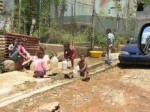Students plan water improvement for impoverished community

This summer, a group of USF students are spending their time attempting to solve the world’s drinking water crisis, starting with the Dominican Republic.
USF’s chapter of Engineers Without Borders (EWB) traveled in April to the Dominican Republic to start a project that would bring clean drinking water to the underdeveloped community of Miramar. EWB’s trip served as an observation and assessment period, which forced the students to step out of their engineering roles and exercise anthropological skills.
“None of our classes trained us for this,” said Gary Hendrick, EWB’s technical lead for the project.
When Hendrick, along with six other EWB members, visited Miramar on April 10, he observed the struggles Dominicans face. The residents of Miramar must travel miles to obtain contaminated drinking water from cracks in a dilapidated water tower, he said. Simple tasks like washing clothes or cooking become burdens under these conditions.
“A lot of this burden falls on the children,” said Daniel Yeh, civil and environment engineering assistant professor and faculty adviser for EWB. “If they spend their day carrying water, they don’t have any time for school.”
The students’ trip allowed them to hear the residents’ needs directly from the source. The students organized town hall meetings and conducted interviews within the community. These social encounters forced them to play roles beyond the scope of the engineering curriculum, Hendrick said, and cultural differences compounded the challenge.
“For several of us there was a language barrier,” he said. “We were able to overcome that by working with our translators.”
However, the project depended on successfully incorporating the preferences of the local residents.
“The last thing you want to do is provide a solution no one is interested in,” Yeh said.
The Dominicans are expected to use and maintain the system that EWB will put in place, so their interest is vital to a long-lasting solution.
“It is a lifetime investment, so (enthusiasm for the project) really has to come from inside the community,” Hendrick said.
The project, titled “Water for Miches,” will supply nearly 500 residents living in the Miches region of the Dominican Republic, in which Miramar is located, with a luxury few have experienced.
“Many of those people have lived (in Miramar) their whole lives and they have never had access to water,” Hendrick said.
Projects like this are the primary focus of EWB, an organization composed of students focused on various disciplines in the College of Engineering and engineering professionals from the community.
“They are a bunch of very dedicated students,” Yeh said. “It’s amazing that they can put so much time into this organization on top of their coursework.”
EWB faces another challenge that may be as great as Miramar’s water crisis: funding the project. Every penny used for Water for Miches must be raised by the organization, Yeh said.
Scholarships from the Dr. Kiran C. Patel Center for Global Solutions guarantee enough funds to send five students to the Dominican Republic, but more money is needed to complete the project, Hendrick said.
EWB held a 5k race this spring which raised $1,000, but Yeh said that is “too little, too slow.” What the organization really needs, he said, is corporate sponsorship. However, the students are grateful for any donation, no matter how small, Hendrick said.
During the summer, students in EWB will discuss what they learned in Miramar and develop a solution to the water dilemma, Yeh said. In late July, the students will travel back to Miramar to implement their plan.
While the project will directly benefit nearly 500 people, the true goal, Hendrick said, is to publicly address the global water shortage.
“There’s over a billion people in the world that don’t have access to clean drinking water,” he said. “We would like to increase awareness about this water issue in general.”







